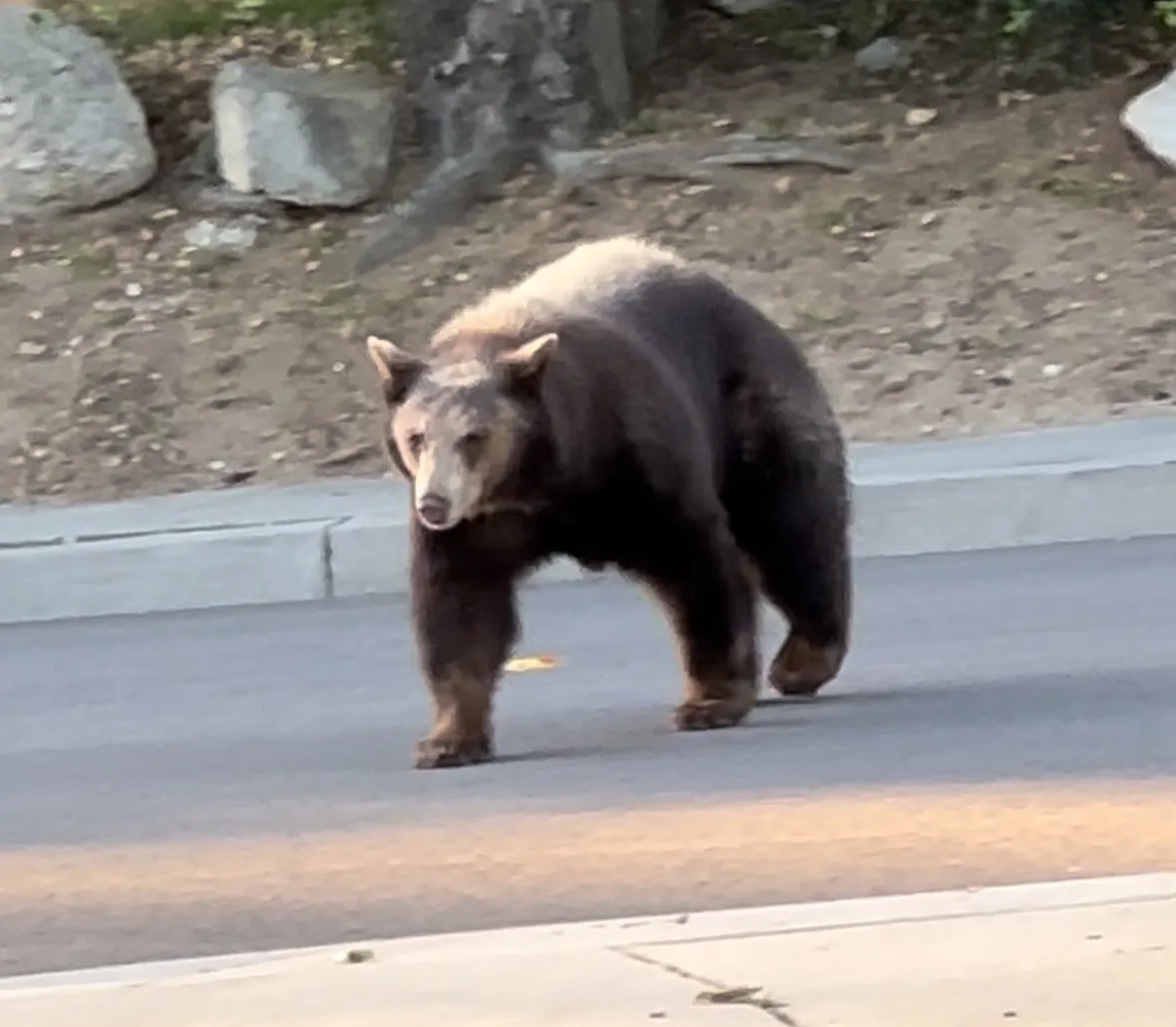Daniela Anino has generally been happy with her cozy home at the border of Sierra Madre, a tiny suburb in the lush foothills of the San Gabriel Mountains. But lately, one of her neighbors has been exhibiting some boundary issues.
First, he started stopping by uninvited for dinner. Then she’d find him hanging around in her driveway at odd hours. Most recently, he’s been breaking into her backyard to swim in her pool without permission.
He’s entitled, pushy, and also weighs about 400 pounds and sports a thick coat of fur — because he is a black bear.
“This guy, I see him every day now,” says Anino. “The younger bears come more during the day, they're more curious, they're not so respectful of the rules.”
Over the five years she’s lived here, Anino says she’s seen more and more bears wandering the neighborhood, and their behaviors have been getting bolder. Human encounters with black bears are booming all over LA’s foothill communities — and that’s left state and local officials at a loss over how to handle the ursine explosion.
“You have those that want you to harm the bear. And then you have those community members that want you to hug a bear. That's the reality of it,” says Sierra Madre Police Chief Gustavo Barrientos.

Daniela Anino, who lives on the border of Sierra Madre, says this one young black bear has been repeatedly visiting her home in recent months — and even broke into her swimming pool last week. Photo courtesy of Daniela Anino.
In 2022 alone, police in Sierra Madre say they received 130 calls about bears — up from just over 100 in 2020. And last year, 17 of those incidents involved bears breaking into cars, homes, or swimming pools.
“We've tripled – almost 300% – of incidents where the bear enters a residence or causes property damage,” says Barrientos.
But while cops will respond to these calls, there’s really not much they can do. Unless the animal is acting aggressive — which black bears almost never do — police policy is mainly to warn other people a bear is around, and to avoid making it angry.
“I think our citizens are under the impression that we go and, number one, we're going to shoot a bear, number two, start using some sort of force to move it northward. We don't do that. I think there's more harm with doing it than good,” says Barrientos.
Some locals, like Anino, are fine with this live-and-let-live policy. She says the bears haven’t caused her any real problems aside from sometimes dragging trash into her yard: “At least in my experience, I've been able to coexist with them peacefully.”
In her eyes, bears have as much right to be here as people. And with so many cars around, she’s more worried about the animals’ health than her own. She just keeps her kids far away, and her garbage bins locked.
But other Sierra Madre residents don’t feel so warm and fuzzy about the animals. Cynthia Compton keeps a stun gun on hand to scare the bears away because she’s tired of them repeatedly raiding her bird feeder and trash bins. She says she fears for her safety.
“I don't like it. It's nerve-wracking. I've seen him right there by my living room window. And I'm pounding on the window: ‘Go bear, go, get out of here,’ and pull out the stun gun,” says Compton.
She says officials need to be doing more – if she had it her way, she would have all the bears shipped away.
“I would like to see them be taken back to Yosemite where they came from. They don't belong here. This is not their native territory, they weren't here before humans,” she says. “They're getting too comfortable around people and around people's houses and coming into people's houses.”
Compton is right that the black bears now roaming the San Gabriel foothills are not native to the area. In the 1930s, bears were a big attraction in Yosemite National Park, where rangers created special “bear pits” filled with trash to attract them for spectators’ entertainment.
Unsurprisingly, those bears acquired a taste for human food. Once they started breaking into coolers and cabins, they transformed from a novelty to a nuisance.
So, the state came up with a plan: Ship 27 bears to Southern California to replace the California grizzlies that had been hunted into extinction in the state.
Those bears’ many, many grand-cubs are the ones that roam the foothills today.
These descendents still haven’t lost their taste for human food — which is part of why they’re showing up more often in these urban areas.
“Bears in an urban environment, they can easily get a full day's meal just by visiting all the bird feeders in the neighborhood, or all the garbage cans in the neighborhood,” says Rebecca Barboza, a biologist for the Department of Fish and Wildlife.
As LA’s foothill communities have crept closer to the mountains, climate change-related issues like fire and drought have made the forest less hospitable for bears, pushing more of them to make the commute to LA.
And that’s paid off in terms of population growth.
“The animals that are living in these urban areas are doing so well that they're able to reproduce more, and those offspring are able to survive to adulthood,” says Barboza. “So we've got an unnaturally dense population, we believe, within the urban zone.”

Daniela Anino and her neighbor Jim Skinner say they’ve seen an uptick in black bears roaming their neighborhood, which is just about a mile from the foothills of the San Gabriel Mountains. Photo by Zoie Matthew.
In Sierra Madre, officials say they’ve tried everything from banning the feeding of wildlife to implementing a program to distribute bear-proof trash cans to quell the problem — but the creatures just keep coming.
So, they’re asking for backup from the state. In April, the Sierra Madre City Council passed a resolution to declare bears a public safety threat in the city. Less a policy shift and more a plea for help, it urged the state Department of Fish and Wildlife to beef up its bear-prevention efforts in the region.
Officials say the state helped create this problem to begin with — and they have a lot more resources to deal with it, too.
“We’re very small, we're 11,000 people, we don't even have a traffic light in town. So you can imagine we don't have professionals. We don't have biologists,” says James Carlson, a management analyst for Sierra Madre.
But Barboza from Fish and Wildlife says this isn’t just a Sierra Madre problem — the number of black bears has tripled statewide over the past four decades, which makes figuring out a long-term solution tough.
“If we try relocation, if we try captivity, if we try euthanasia, there's still so many bears in the area. If one leaves, there's going to be another one that's going to start doing the same behaviors,” she says.
Last year, the Department of Fish and Wildlife revamped its bear policy and created a whole team of human-wildlife conflict specialists who deal with bears on a case-by-case basis. Depending on the animals’ behavior, the department might relocate or even put down an animal. But Barboza says at the end of the day, public education is still the best tactic they’ve got.
“If people are still leaving doors open, if they're still leaving garbage available, if they're still leaving food out for the bears, then nothing is really going to work.”
She is, however, feeling hopeful about a new “trap, tag, haze” program the department is rolling out, which they have piloted in Lake Tahoe to mixed community response.
Under the program, state officials will capture the bears one by one, and tag them so they can track their movement. They say this will help them learn more about bear behavior, and give them a better sense of how many there actually are.
The final step is to haze the creatures with loud noises and beanbag projectiles, which they hope will drive the bears back into the woods for good. But, it remains to be seen how effective that will be — in Lake Tahoe, it’s worked on some bears, while others have headed right back to the trash buffet.
So for now, Anino will probably continue getting visits from her furry neighbor. She doesn’t mind — in fact, she says she’d miss the creatures if they were gone: “They are really cute. And when they come with the babies, their cubs, boy is it a beautiful sight.”
